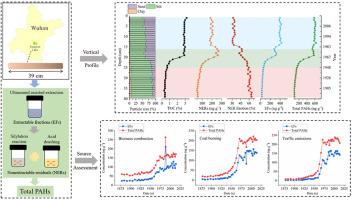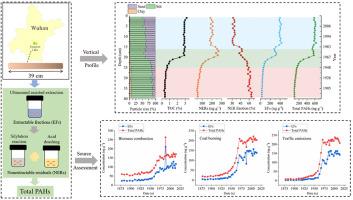不可提取残留物对湖泊沉积物岩心历史多环芳烃污染及来源贡献研究的影响
IF 7.3
2区 环境科学与生态学
Q1 ENVIRONMENTAL SCIENCES
引用次数: 0
摘要
多环芳烃(PAHs)是反映沉积物岩心中历史人类活动和能源使用的常用代用物,但不可提取残留物(ner)的形成是否会扭曲这一信息存在不确定性。本研究探讨了武汉唐浔湖沉积物岩心内NER形成对历史多环芳烃污染及源贡献的影响。为提高检测精度,采用硅烷化和酸脱灰耦合的组合策略对Σ15PAH的多环芳烃进行了检测,检测浓度为48.08 ~ 266.27 ng g-1,占总多环芳烃(可提取馏分与ner之和)的30.6 ~ 64.5%。多环芳烃(PAHs)总量和沉积物老化时间分别占变异率的88.6%和1.9%。在21 ~ 39 cm深度,NER的形成显著改变了样品的环数组成。此外,Fla/(Fla+PYR)的比率受到显著影响,导致基于该比率的来源识别结果发生变化。在20世纪50年代以前的样本中,NER的形成改变了生物质燃烧、煤炭燃烧和交通排放的大部分百分位数贡献值,尤其是前两个来源。有趣的是,煤炭消费量(1980年代至2020年代)与煤炭燃烧的来源归属之间存在很强的相关性(r = 0.53, p <;0.05),但可提取部分没有(r = 0.34, p >;0.05)。这些发现强调了NER的形成对沉积物岩心中历史多环芳烃污染研究的重要影响,以及在未来研究中考虑NER的必要性。本文章由计算机程序翻译,如有差异,请以英文原文为准。


Effects of nonextractable residual formation on the study of historical PAH pollution and source contribution in a lake sediment core
Polycyclic aromatic hydrocarbons (PAHs) are common proxies for mirroring historical human activities and energy usage in sediment cores, but uncertainty exists about whether the formation of nonextractable residuals (NERs) might distort this information. This study investigated the influences of NER formation on the research of historical PAH pollution and source contribution within a sediment core of Tangxun Lake (Wuhan, China). To improve detection accuracy, a combined strategy coupling silylation and acid deashing was used to measure the NERs of Σ15PAH, with concentrations of 48.08–266.27 ng g−1, accounting for 30.6–64.5 % of the total PAHs (the sum of extractable fractions and NERs). The proportions were primarily influenced by the total PAHs and sediment aging duration, explaining 88.6 % and 1.9 % of the variability, respectively. The NER formation significantly altered the ring number composition of samples at depths of 21–39 cm. Furthermore, the ratios of Fla/(Fla + PYR) were conspicuously impacted, leading to shifts in source identification outcomes predicated on this ratio. The NER formation changed the majority of the percentile contribution values of biomass combustion, coal burning, and traffic emissions, especially for the first two sources in pre-1950s samples. Interestingly, a strong correlation between coal consumption (1980s–2020s) and the source attribution of coal burning was observed for the total PAHs (r = 0.53, p < 0.05), but not for extractable fractions (r = 0.34, p > 0.05). These findings emphasize the significant impact of NER formation on historical PAH pollution studies in sediment cores and the need to consider NERs in future research.
求助全文
通过发布文献求助,成功后即可免费获取论文全文。
去求助
来源期刊

Environmental Pollution
环境科学-环境科学
CiteScore
16.00
自引率
6.70%
发文量
2082
审稿时长
2.9 months
期刊介绍:
Environmental Pollution is an international peer-reviewed journal that publishes high-quality research papers and review articles covering all aspects of environmental pollution and its impacts on ecosystems and human health.
Subject areas include, but are not limited to:
• Sources and occurrences of pollutants that are clearly defined and measured in environmental compartments, food and food-related items, and human bodies;
• Interlinks between contaminant exposure and biological, ecological, and human health effects, including those of climate change;
• Contaminants of emerging concerns (including but not limited to antibiotic resistant microorganisms or genes, microplastics/nanoplastics, electronic wastes, light, and noise) and/or their biological, ecological, or human health effects;
• Laboratory and field studies on the remediation/mitigation of environmental pollution via new techniques and with clear links to biological, ecological, or human health effects;
• Modeling of pollution processes, patterns, or trends that is of clear environmental and/or human health interest;
• New techniques that measure and examine environmental occurrences, transport, behavior, and effects of pollutants within the environment or the laboratory, provided that they can be clearly used to address problems within regional or global environmental compartments.
 求助内容:
求助内容: 应助结果提醒方式:
应助结果提醒方式:


